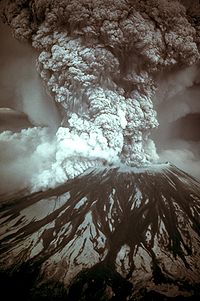
Photo from wikipedia
Abstract. Debris avalanches caused by volcano sector collapse often form characteristic depositional landforms such as hummocks. Sedimentological and geomorphological analyses of debris avalanche deposits (DADs) are crucial to clarify the… Click to show full abstract
Abstract. Debris avalanches caused by volcano sector collapse often form characteristic depositional landforms such as hummocks. Sedimentological and geomorphological analyses of debris avalanche deposits (DADs) are crucial to clarify the size, mechanisms, and emplacement of debris avalanches. We describe the morphology of hummocks on the northeastern flank of Mt. Erciyes in Kayseri, central Turkey, likely formed in the late Pleistocene. Using a remotely piloted aircraft system (RPAS) and the structure-from-motion and multi-view stereo (SfM–MVS) photogrammetry, we obtained high-definition digital elevation model (DEM) and orthorectified images of the hummocks to investigate their geometric features. We estimated the source volume of the DAD by reconstructing the topography of the volcano edifice using a satellite-based DEM. We examined the topographic cross sections based on the slopes around the scar regarded as remnant topography. Spatial distribution of hummocks is anomalously concentrated at a certain distance from the source, unlike those that follow the distance–size relationship. The high-definition land surface data by RPAS and SfM revealed that many of the hummocks are aligned toward the flow direction of the debris avalanche, suggesting that the extensional regime of the debris avalanche was dominant. However, some displaced hummocks were also found, indicating that the compressional regime of the flow contributed to the formation of hummocks. These indicate that the flow and emplacement of the avalanche were constrained by the topography. The existing caldera wall forced the initial eastward flow to move northward, and the north-side caldera wall forced the flow into the narrow and steepened outlet valley where the sliding debris underwent a compressional regime, and out into the unconfined terrain where the debris was most likely emplaced on an extensional regime. Also, the estimated volume of 12–15 × 10 8 m 3 gives a mean thickness of 60–75 m, which is much deeper than the reported cases of other DADs. This suggests that the debris avalanche must have flowed further downstream and beyond the current DAD extent. Assessments of the DAD incorporating the topographic constraints can provide further insights into the risk and mitigation of potential disasters in the study area.
Journal Title: Natural Hazards and Earth System Sciences
Year Published: 2018
Link to full text (if available)
Share on Social Media: Sign Up to like & get
recommendations!